Children of Burmese Workers in Thailand
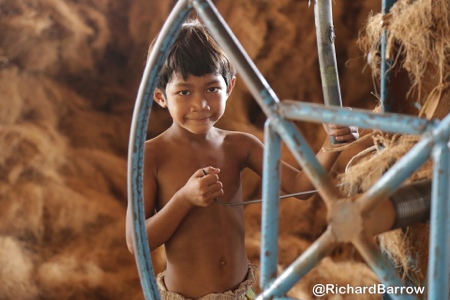
Recently I visited a coconut factory in Prachuap Khiri Khan in Southern Thailand. They were processing the husks of coconuts to make various products like charcoal and timber for construction. The aim of the visit was to see how they did this and the products that they sold on the market. But, my attention was more drawn to the kids of the workers who were playing around the factory grounds.
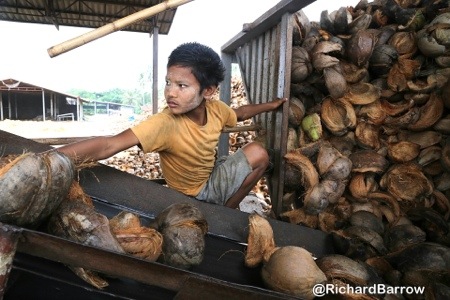
It is not known exactly how many migrant workers there are in Thailand. Estimates seem to vary between one and two million. Only a small percentage of these are legal. Most workers come from neighbouring countries such as Cambodia, Myanmar and Laos. They are often poorly paid and work in labour intensive jobs such as in seafood, construction, agriculture and also domestic care. The kind of jobs that most Thais don’t want to do.
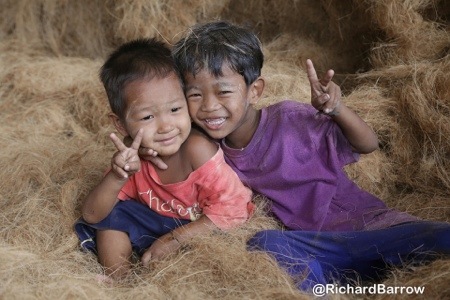
Although migrant workers are given little rights, the Thais will certainly miss them if they all leave as they make up about 10% of Thailand’s labour force. The workers at this factory told us that they were earning as little as 5,000 Baht a month which is far below the minimum wage in Thailand.
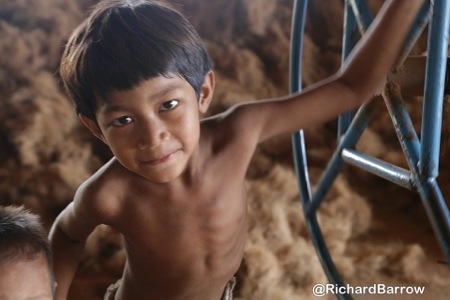
It is estimated that there could be as many as 500,000 migrant children in Thailand. Officially they are allowed to enrol in the local school but in practice this doesn’t happen often. Either they are not welcome or the parents cannot afford any of the school fees. So, as a consequence, their parents’ workplace becomes the children’s playground and school.
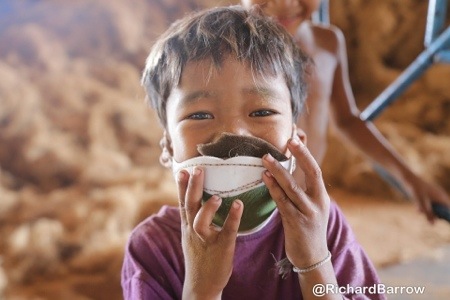
Some places this is not so bad. But construction sites and farms are not safe places for children to be. The coconut factory isn’t a good place for them too. Mainly because of the dust from the coconut husks. Their parents were wearing masks but the children weren’t. They were also helping their parents at times with manual work.
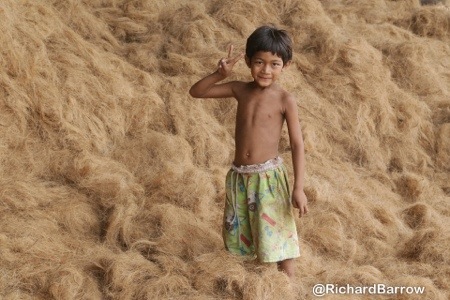
In many cases you can understand why parents don’t want to send their kids to school. Not only because they cannot afford to do this but also because they badly need money from manual work to help support the family. Thailand has often denied to the international community that they don’t have child workers. But these pictures tell a different story.

Where do we draw the line about kids helping their parents at work? I have sometimes seen them in places like noodle shops. Is this alright to help their parents after school? The kids at the coconut factory were also helping their parents sometimes. But then, this obviously goes from part-time to full-time very quickly as soon as they become able to carry out the work by themselves.


Hi Richard i have been building schools for construction workers children for the last 10 years .. many of the children are not just from Burma Cambodia but also Thai… There has been no government funding and no international funding .. but lots of problems over the years but we will keep going step by step .. if one woman can make a difference it cannot be too hard !!!! .. its taken 10 years so far and only now finally do i feel i am not banging my head on the wall but we are no where near there yet !!!
https://www.youtube.com/watch?v=Hh-7BSTHjis
https://www.youtube.com/watch?v=Hh-7BSTHjis
Simple solution – build a school for them. Yeah, I know you will come up with all the reasons why that is impossible. Details, mere details. But one thing people from just about everywhere, of whatever nationality, of whatever colour, of whatever religion, have in common is a kindness towards children. Now let’s hear the obstacles and work out how to overcome them.
Child Labour is very healthy; not just in Thailand, but all of Southeast Asia. Many insist that children helping their parents is not considered work. Some argue that it helps to feed the family. Am looking forward to people actually putting their money where their mouth is on this issue. I’ve not heard any real resolve yet, and as long as countries are not signatories of the Refugee Convention, nothing can, or will be done for the refugees:
The list of signatories is here:
http://en.wikipedia.org/wiki/Convention_relating_to_the_Status_of_Refugees
Aid to these people are sporadic at best, and often gets “hijacked”.
See also reference on Rohingya Refugee Camps here:
http://www.rohingyablogger.com/
It’s important to be aware that this is not only a problem for Burmese immigrants. There’s a surprising amount of Thai children also who grow up in extreme poverty, get little schooling and start working at a very young age. They are of course totally ignored by the more affluent part of Thai society.
I believe you underestimate the number of immigrant workers in Thailand. I’ve heard estimates of around 2 million, and around half of them or more are now legally here with ID card and passport (which is only valid in Myanmar and Thailand). A couple of years ago, the governor of Tak estimated that there were around 500,000 Burmese immigrants in that province alone. Then there are the Khmer and Lao immigrants. From what I’ve heard in Phnom Penh, they estimate that between 500,000 and 1 million of their countrymen are in Thailand working, but I doubt that they really know.
With a fertility rate of only 1.6 (they need 2.1-2.3 to sustain a stable population), Thailand will need all the workers they can get, but if conditions improve in the neighbouring countries, attracting them might become a difficult task in the future, particularly if they continue to treat foreign workers the way they do. I believe we will see a lot of industries depending on low-cost labour migrate to neighbouring countries the next ten years, but that’s not necessarily a bad thing for Thailand.
Correction: should be 2 million Burmese workers.
Thank you for this post Richard. I’ve been concerned about the Burmese immigrants and their kids since I moved to Phuket a few months back. They are everywhere here, the conditions in their camps not fit for stray dogs, the way they are transported on trucks around the island not fit for cattle. And their children – there is a Burmese lady working in the resort that I live in. She often brings her 12 years old daughter along. The girl (her name is Da U) helps her mom with cleaning, laundry and stuff. When I asked my landlord why isn’t the girl at school she replied “Burma people don’t go to school”.
What I always miss in such disturbing posts is call for action and means to do it. What can WE do?
Good question Matt. The only thing I can do at the moment is raise awareness by posting pictures like these.
Good report Richard however it is all part of the master plan to ensure cheap labor and will not change anytime soon I’m afraid.
I care, you care but we are not the powers that be who promote these horrible conditions on humanity.
BTW I am not Peter Marshall!
Thanks. When I get back I will look into more about the children of migrant workers in Thailand. Without proper education they don’t have much hope of a future either here in Thailand or their home country. If anyone has links or information about this then please post here.